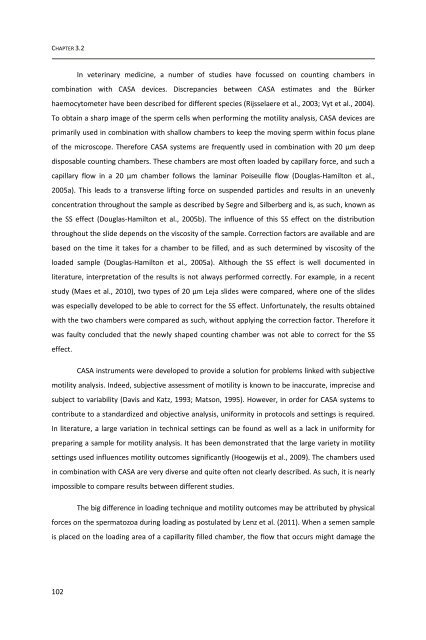view - Department of Reproduction, Obstetrics and Herd Health
view - Department of Reproduction, Obstetrics and Herd Health
view - Department of Reproduction, Obstetrics and Herd Health
You also want an ePaper? Increase the reach of your titles
YUMPU automatically turns print PDFs into web optimized ePapers that Google loves.
CHAPTER 3.2<br />
102<br />
In veterinary medicine, a number <strong>of</strong> studies have focussed on counting chambers in<br />
combination with CASA devices. Discrepancies between CASA estimates <strong>and</strong> the Bürker<br />
haemocytometer have been described for different species (Rijsselaere et al., 2003; Vyt et al., 2004).<br />
To obtain a sharp image <strong>of</strong> the sperm cells when performing the motility analysis, CASA devices are<br />
primarily used in combination with shallow chambers to keep the moving sperm within focus plane<br />
<strong>of</strong> the microscope. Therefore CASA systems are frequently used in combination with 20 µm deep<br />
disposable counting chambers. These chambers are most <strong>of</strong>ten loaded by capillary force, <strong>and</strong> such a<br />
capillary flow in a 20 µm chamber follows the laminar Poiseuille flow (Douglas-Hamilton et al.,<br />
2005a). This leads to a transverse lifting force on suspended particles <strong>and</strong> results in an unevenly<br />
concentration throughout the sample as described by Segre <strong>and</strong> Silberberg <strong>and</strong> is, as such, known as<br />
the SS effect (Douglas-Hamilton et al., 2005b). The influence <strong>of</strong> this SS effect on the distribution<br />
throughout the slide depends on the viscosity <strong>of</strong> the sample. Correction factors are available <strong>and</strong> are<br />
based on the time it takes for a chamber to be filled, <strong>and</strong> as such determined by viscosity <strong>of</strong> the<br />
loaded sample (Douglas-Hamilton et al., 2005a). Although the SS effect is well documented in<br />
literature, interpretation <strong>of</strong> the results is not always performed correctly. For example, in a recent<br />
study (Maes et al., 2010), two types <strong>of</strong> 20 µm Leja slides were compared, where one <strong>of</strong> the slides<br />
was especially developed to be able to correct for the SS effect. Unfortunately, the results obtained<br />
with the two chambers were compared as such, without applying the correction factor. Therefore it<br />
was faulty concluded that the newly shaped counting chamber was not able to correct for the SS<br />
effect.<br />
CASA instruments were developed to provide a solution for problems linked with subjective<br />
motility analysis. Indeed, subjective assessment <strong>of</strong> motility is known to be inaccurate, imprecise <strong>and</strong><br />
subject to variability (Davis <strong>and</strong> Katz, 1993; Matson, 1995). However, in order for CASA systems to<br />
contribute to a st<strong>and</strong>ardized <strong>and</strong> objective analysis, uniformity in protocols <strong>and</strong> settings is required.<br />
In literature, a large variation in technical settings can be found as well as a lack in uniformity for<br />
preparing a sample for motility analysis. It has been demonstrated that the large variety in motility<br />
settings used influences motility outcomes significantly (Hoogewijs et al., 2009). The chambers used<br />
in combination with CASA are very diverse <strong>and</strong> quite <strong>of</strong>ten not clearly described. As such, it is nearly<br />
impossible to compare results between different studies.<br />
The big difference in loading technique <strong>and</strong> motility outcomes may be attributed by physical<br />
forces on the spermatozoa during loading as postulated by Lenz et al. (2011). When a semen sample<br />
is placed on the loading area <strong>of</strong> a capillarity filled chamber, the flow that occurs might damage the









